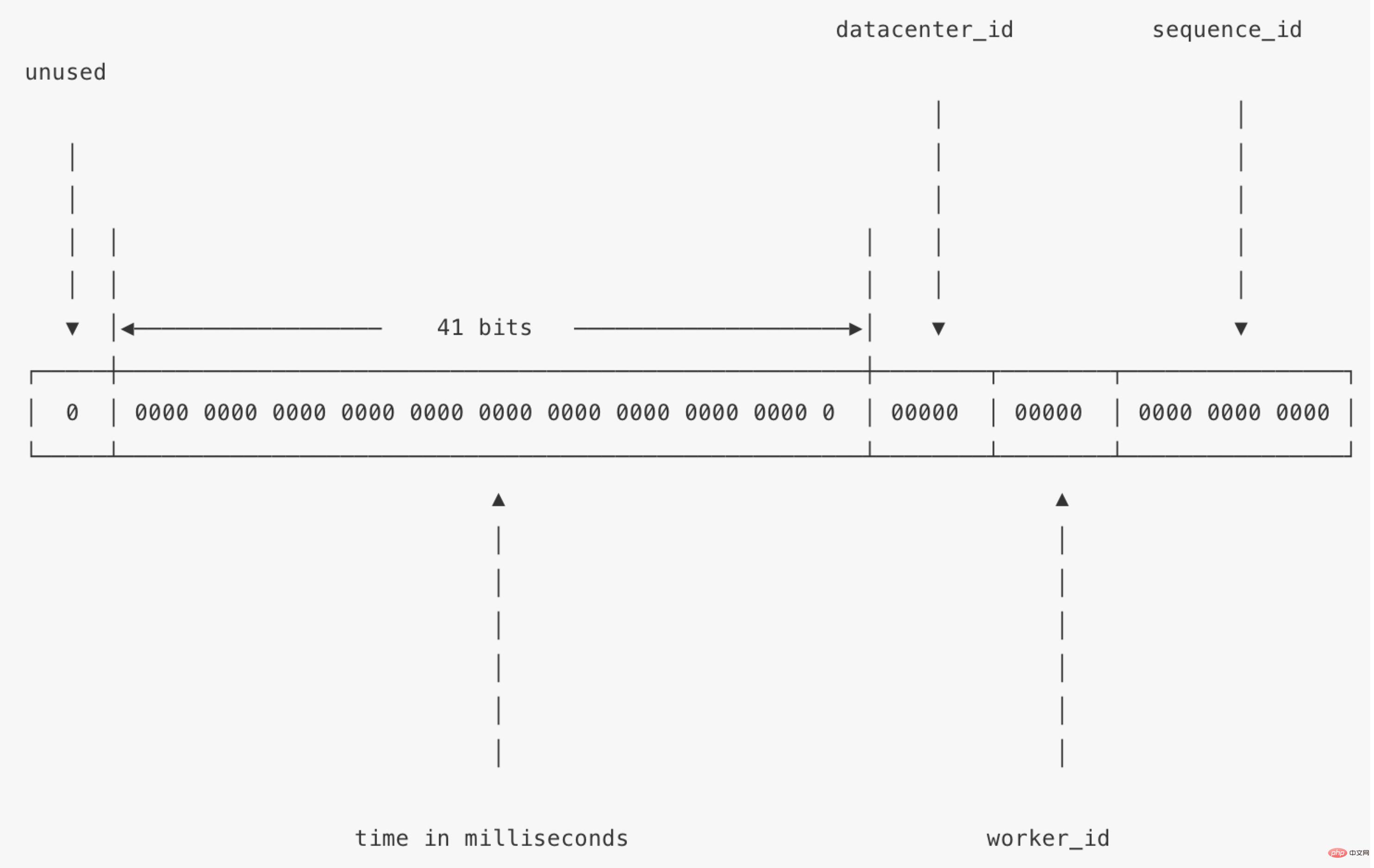PHP implements Snowflake to generate distributed unique ID

Twitter's snowflake is widely used in distributed generation of unique UUIDs, and there are many algorithms based on some variants of snowflake on the Internet. Many UUIDs generated using snowflake are used in distributed scenarios. I have read several articles on the Internet that implement PHP without considering thread safety. Now that PHP has the support of Swoole's locks and coroutines, it is very convenient for us to develop thread-safe and high-concurrency simulations. Here we use PHP combined with Swoole to learn how to implement the simplest snowflake (I haven't written PHP for a long time, and I feel like I don't have an IDE. Can't write PHP anymore).
Let’s first look at the following snowflake structure:  The generated value is 64 bits, divided into 4 parts:
The generated value is 64 bits, divided into 4 parts:
- The first bit is the sign bit, the highest Bit 0 indicates a positive number
- The second part of 41 bits is used to record the timestamp when the ID is generated, in milliseconds, so the value range represented by this part is 2^41 - 1 (69 years), It is an offset relative to a certain time
- The 10 bits in the third part represent the ID of the working node, indicating that the value range is 2^10 - 1, which is equivalent to supporting 1024 nodes
- The 12 bits in the fourth part represent the cyclic self-increment ID generated by each working node every millisecond. It can generate up to 2^12 -1 IDs. If it exceeds zero, it will wait for the next millisecond to re-increment.
Post the code first:
<?php class Snowflake
{
const EPOCH = 1543223810238; // 起始时间戳,毫秒
const SEQUENCE_BITS = 12; //序号部分12位
const SEQUENCE_MAX = -1 ^ (-1 << self::SEQUENCE_BITS); // 序号最大值
const WORKER_BITS = 10; // 节点部分10位
const WORKER_MAX = -1 ^ (-1 << self::WORKER_BITS); // 节点最大数值
const TIME_SHIFT = self::WORKER_BITS + self::SEQUENCE_BITS; // 时间戳部分左偏移量
const WORKER_SHIFT = self::SEQUENCE_BITS; // 节点部分左偏移量
protected $timestamp; // 上次ID生成时间戳
protected $workerId; // 节点ID
protected $sequence; // 序号
protected $lock; // Swoole 互斥锁
public function __construct($workerId)
{
if ($workerId < 0 || $workerId > self::WORKER_MAX) {
trigger_error("Worker ID 超出范围");
exit(0);
}
$this->timestamp = 0;
$this->workerId = $workerId;
$this->sequence = 0;
$this->lock = new swoole_lock(SWOOLE_MUTEX);
}
/**
* 生成ID
* @return int
*/
public function getId()
{
$this->lock->lock(); // 这里一定要记得加锁
$now = $this->now();
if ($this->timestamp == $now) {
$this->sequence++;
if ($this->sequence > self::SEQUENCE_MAX) {
// 当前毫秒内生成的序号已经超出最大范围,等待下一毫秒重新生成
while ($now timestamp) {
$now = $this->now();
}
}
} else {
$this->sequence = 0;
}
$this->timestamp = $now; // 更新ID生时间戳
$id = (($now - self::EPOCH) workerId sequence;
$this->lock->unlock(); //解锁
return $id;
}
/**
* 获取当前毫秒
* @return string
*/
public function now()
{
return sprintf("%.0f", microtime(true) * 1000);
}
}In fact, the logic is not complicated. Explain the bit operations in the code:
-1 ^ (-1 <p>The last part is shifted left and then ORed: </p><pre class="brush:php;toolbar:false">(($now - self::EPOCH) workerId sequence;
The main thing here is to shift the three parts except the first sign bit to the left by the corresponding offset, and reintegrate them into the above snowflake structure through the OR operation. For example, we use 3 parts and 4 bits to demonstrate The merge operation:
0000 0000 0010 --左移0位--> 0000 0000 0010 0000 0000 0100 --左移4位--> 0000 0100 0000 --或操作-->1000 0100 0010 0000 0000 1000 --左移8位--> 1000 0000 0000
Let’s violently test it with the help of Swoole’s coroutine and channel to see if the generated IDs will be repeated:
$snowflake = new Snowflake(1);
$chan = new chan(100000);
$n = 100000;
for ($i = 0; $i getId();
$chan->push($id);
});
}
go(function () use ($chan, $n) {
$arr = [];
for ($i = 0; $i pop(); // PHP Swoole的channel一定要写在go(func)的协程里面!?
if (in_array($id, $arr)) {
exit("ID 已存在");
}
array_push($arr, $id);
}
});
$chan->close();
echo "ok";After running it, it is indeed not the case Duplicate IDs appeared. By the way, I used Golang to implement snowflake and ran the same test in co-program mode. The execution time of PHP was about 12 seconds, while Golang only took 1 second. Please correct me if there are any errors in the article, thank you.
The above is the detailed content of PHP implements Snowflake to generate distributed unique ID. For more information, please follow other related articles on the PHP Chinese website!

Hot AI Tools

Undresser.AI Undress
AI-powered app for creating realistic nude photos

AI Clothes Remover
Online AI tool for removing clothes from photos.

Undress AI Tool
Undress images for free

Clothoff.io
AI clothes remover

Video Face Swap
Swap faces in any video effortlessly with our completely free AI face swap tool!

Hot Article

Hot Tools

Notepad++7.3.1
Easy-to-use and free code editor

SublimeText3 Chinese version
Chinese version, very easy to use

Zend Studio 13.0.1
Powerful PHP integrated development environment

Dreamweaver CS6
Visual web development tools

SublimeText3 Mac version
God-level code editing software (SublimeText3)

Hot Topics
 1664
1664
 14
14
 1422
1422
 52
52
 1316
1316
 25
25
 1268
1268
 29
29
 1240
1240
 24
24
 Explain JSON Web Tokens (JWT) and their use case in PHP APIs.
Apr 05, 2025 am 12:04 AM
Explain JSON Web Tokens (JWT) and their use case in PHP APIs.
Apr 05, 2025 am 12:04 AM
JWT is an open standard based on JSON, used to securely transmit information between parties, mainly for identity authentication and information exchange. 1. JWT consists of three parts: Header, Payload and Signature. 2. The working principle of JWT includes three steps: generating JWT, verifying JWT and parsing Payload. 3. When using JWT for authentication in PHP, JWT can be generated and verified, and user role and permission information can be included in advanced usage. 4. Common errors include signature verification failure, token expiration, and payload oversized. Debugging skills include using debugging tools and logging. 5. Performance optimization and best practices include using appropriate signature algorithms, setting validity periods reasonably,
 Explain late static binding in PHP (static::).
Apr 03, 2025 am 12:04 AM
Explain late static binding in PHP (static::).
Apr 03, 2025 am 12:04 AM
Static binding (static::) implements late static binding (LSB) in PHP, allowing calling classes to be referenced in static contexts rather than defining classes. 1) The parsing process is performed at runtime, 2) Look up the call class in the inheritance relationship, 3) It may bring performance overhead.
 PHP Program to Count Vowels in a String
Feb 07, 2025 pm 12:12 PM
PHP Program to Count Vowels in a String
Feb 07, 2025 pm 12:12 PM
A string is a sequence of characters, including letters, numbers, and symbols. This tutorial will learn how to calculate the number of vowels in a given string in PHP using different methods. The vowels in English are a, e, i, o, u, and they can be uppercase or lowercase. What is a vowel? Vowels are alphabetic characters that represent a specific pronunciation. There are five vowels in English, including uppercase and lowercase: a, e, i, o, u Example 1 Input: String = "Tutorialspoint" Output: 6 explain The vowels in the string "Tutorialspoint" are u, o, i, a, o, i. There are 6 yuan in total
 What are PHP magic methods (__construct, __destruct, __call, __get, __set, etc.) and provide use cases?
Apr 03, 2025 am 12:03 AM
What are PHP magic methods (__construct, __destruct, __call, __get, __set, etc.) and provide use cases?
Apr 03, 2025 am 12:03 AM
What are the magic methods of PHP? PHP's magic methods include: 1.\_\_construct, used to initialize objects; 2.\_\_destruct, used to clean up resources; 3.\_\_call, handle non-existent method calls; 4.\_\_get, implement dynamic attribute access; 5.\_\_set, implement dynamic attribute settings. These methods are automatically called in certain situations, improving code flexibility and efficiency.
 PHP and Python: Comparing Two Popular Programming Languages
Apr 14, 2025 am 12:13 AM
PHP and Python: Comparing Two Popular Programming Languages
Apr 14, 2025 am 12:13 AM
PHP and Python each have their own advantages, and choose according to project requirements. 1.PHP is suitable for web development, especially for rapid development and maintenance of websites. 2. Python is suitable for data science, machine learning and artificial intelligence, with concise syntax and suitable for beginners.
 PHP in Action: Real-World Examples and Applications
Apr 14, 2025 am 12:19 AM
PHP in Action: Real-World Examples and Applications
Apr 14, 2025 am 12:19 AM
PHP is widely used in e-commerce, content management systems and API development. 1) E-commerce: used for shopping cart function and payment processing. 2) Content management system: used for dynamic content generation and user management. 3) API development: used for RESTful API development and API security. Through performance optimization and best practices, the efficiency and maintainability of PHP applications are improved.
 PHP: A Key Language for Web Development
Apr 13, 2025 am 12:08 AM
PHP: A Key Language for Web Development
Apr 13, 2025 am 12:08 AM
PHP is a scripting language widely used on the server side, especially suitable for web development. 1.PHP can embed HTML, process HTTP requests and responses, and supports a variety of databases. 2.PHP is used to generate dynamic web content, process form data, access databases, etc., with strong community support and open source resources. 3. PHP is an interpreted language, and the execution process includes lexical analysis, grammatical analysis, compilation and execution. 4.PHP can be combined with MySQL for advanced applications such as user registration systems. 5. When debugging PHP, you can use functions such as error_reporting() and var_dump(). 6. Optimize PHP code to use caching mechanisms, optimize database queries and use built-in functions. 7
 The Enduring Relevance of PHP: Is It Still Alive?
Apr 14, 2025 am 12:12 AM
The Enduring Relevance of PHP: Is It Still Alive?
Apr 14, 2025 am 12:12 AM
PHP is still dynamic and still occupies an important position in the field of modern programming. 1) PHP's simplicity and powerful community support make it widely used in web development; 2) Its flexibility and stability make it outstanding in handling web forms, database operations and file processing; 3) PHP is constantly evolving and optimizing, suitable for beginners and experienced developers.




